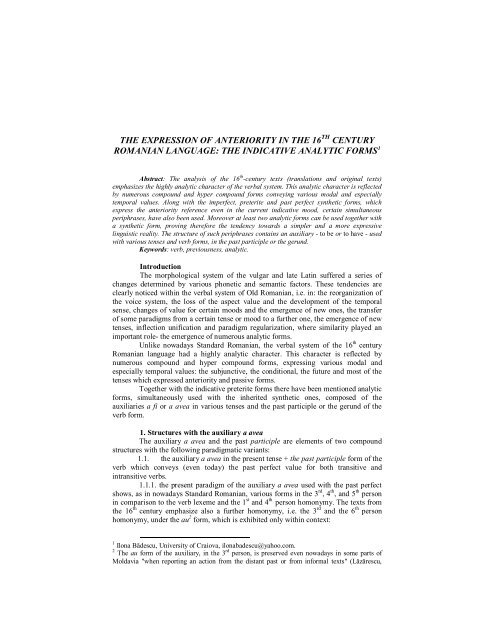language and literature european landmarks of identity
language and literature european landmarks of identity
language and literature european landmarks of identity
You also want an ePaper? Increase the reach of your titles
YUMPU automatically turns print PDFs into web optimized ePapers that Google loves.
THE EXPRESSION OF ANTERIORITY IN THE 16 TH CENTURY<br />
ROMANIAN LANGUAGE: THE INDICATIVE ANALYTIC FORMS 1<br />
Abstract: The analysis <strong>of</strong> the 16 th -century texts (translations <strong>and</strong> original texts)<br />
emphasizes the highly analytic character <strong>of</strong> the verbal system. This analytic character is reflected<br />
by numerous compound <strong>and</strong> hyper compound forms conveying various modal <strong>and</strong> especially<br />
temporal values. Along with the imperfect, preterite <strong>and</strong> past perfect synthetic forms, which<br />
express the anteriority reference even in the current indicative mood, certain simultaneous<br />
periphrases, have also been used. Moreover at least two analytic forms can be used together with<br />
a synthetic form, proving therefore the tendency towards a simpler <strong>and</strong> a more expressive<br />
linguistic reality. The structure <strong>of</strong> such periphrases contains an auxiliary - to be or to have - used<br />
with various tenses <strong>and</strong> verb forms, in the past participle or the gerund.<br />
Keywords: verb, previousness, analytic.<br />
Introduction<br />
The morphological system <strong>of</strong> the vulgar <strong>and</strong> late Latin suffered a series <strong>of</strong><br />
changes determined by various phonetic <strong>and</strong> semantic factors. These tendencies are<br />
clearly noticed within the verbal system <strong>of</strong> Old Romanian, i.e. in: the reorganization <strong>of</strong><br />
the voice system, the loss <strong>of</strong> the aspect value <strong>and</strong> the development <strong>of</strong> the temporal<br />
sense, changes <strong>of</strong> value for certain moods <strong>and</strong> the emergence <strong>of</strong> new ones, the transfer<br />
<strong>of</strong> some paradigms from a certain tense or mood to a further one, the emergence <strong>of</strong> new<br />
tenses, inflection unification <strong>and</strong> paradigm regularization, where similarity played an<br />
important role- the emergence <strong>of</strong> numerous analytic forms.<br />
Unlike nowadays St<strong>and</strong>ard Romanian, the verbal system <strong>of</strong> the 16 th century<br />
Romanian <strong>language</strong> had a highly analytic character. This character is reflected by<br />
numerous compound <strong>and</strong> hyper compound forms, expressing various modal <strong>and</strong><br />
especially temporal values: the subjunctive, the conditional, the future <strong>and</strong> most <strong>of</strong> the<br />
tenses which expressed anteriority <strong>and</strong> passive forms.<br />
Together with the indicative preterite forms there have been mentioned analytic<br />
forms, simultaneously used with the inherited synthetic ones, composed <strong>of</strong> the<br />
auxiliaries a fi or a avea in various tenses <strong>and</strong> the past participle or the gerund <strong>of</strong> the<br />
verb form.<br />
1. Structures with the auxiliary a avea<br />
The auxiliary a avea <strong>and</strong> the past participle are elements <strong>of</strong> two compound<br />
structures with the following paradigmatic variants:<br />
1.1. the auxiliary a avea in the present tense + the past participle form <strong>of</strong> the<br />
verb which conveys (even today) the past perfect value for both transitive <strong>and</strong><br />
intransitive verbs.<br />
1.1.1. the present paradigm <strong>of</strong> the auxiliary a avea used with the past perfect<br />
shows, as in nowadays St<strong>and</strong>ard Romanian, various forms in the 3 rd , 4 th , <strong>and</strong> 5 th person<br />
in comparison to the verb lexeme <strong>and</strong> the 1 st <strong>and</strong> 4 th person homonymy. The texts from<br />
the 16 th century emphasize also a further homonymy, i.e. the 3 rd <strong>and</strong> the 6 th person<br />
homonymy, under the au 2 form, which is exhibited only within context:<br />
1 Ilona Bădescu, University <strong>of</strong> Craiova, ilonabadescu@yahoo.com.<br />
2 The au form <strong>of</strong> the auxiliary, in the 3 rd person, is preserved even nowadays in some parts <strong>of</strong><br />
Moldavia "when reporting an action from the distant past or from informal texts" (Lăzărescu,


